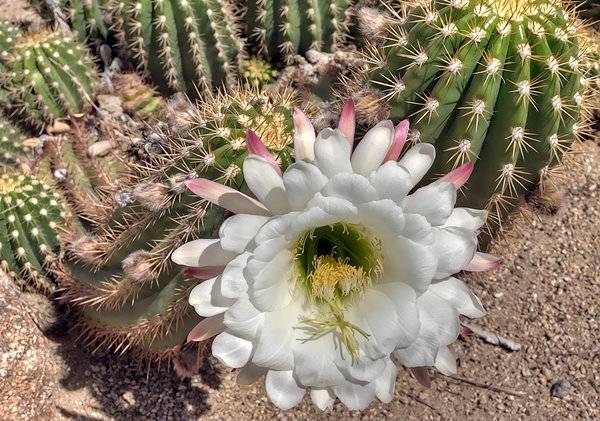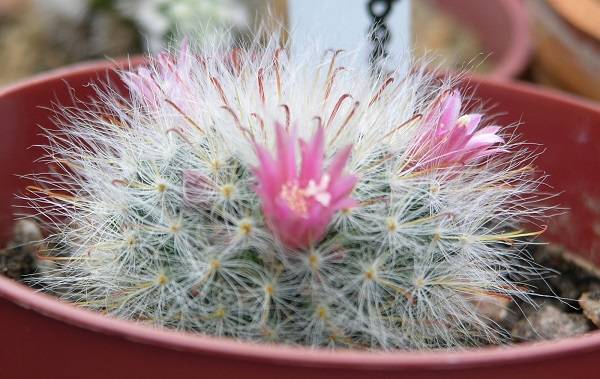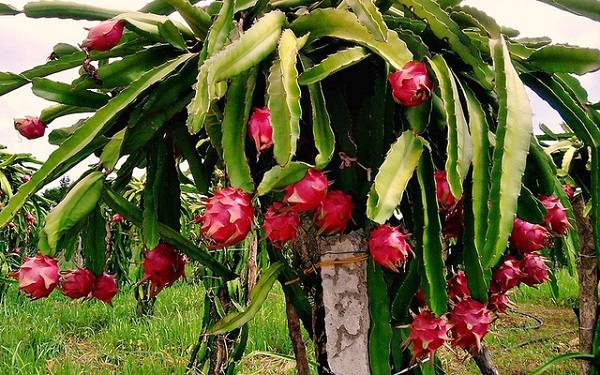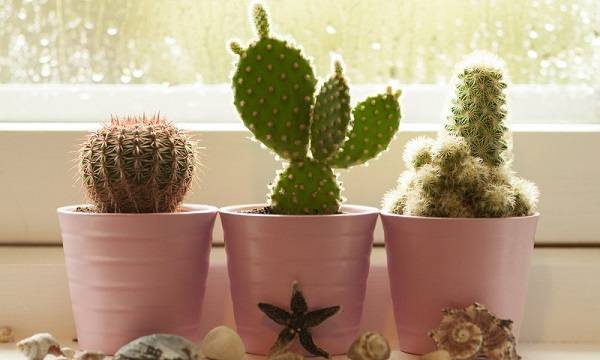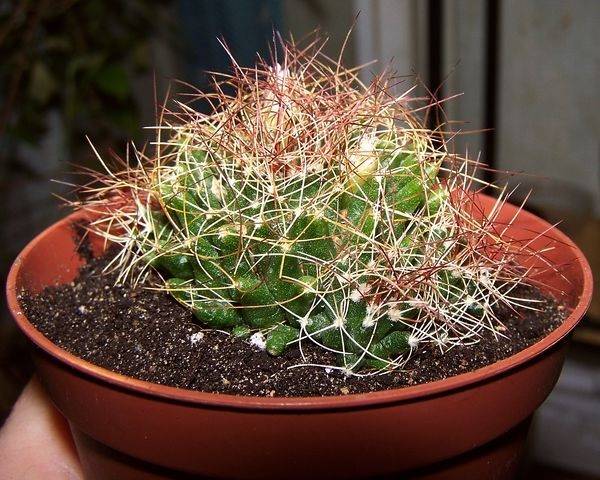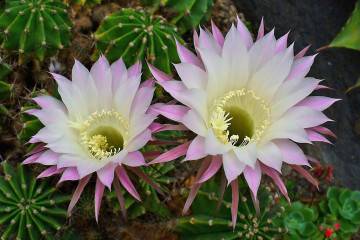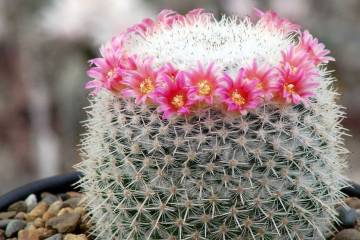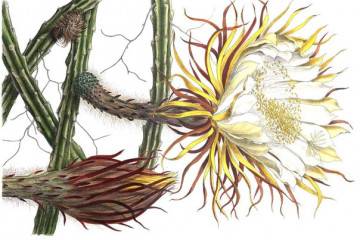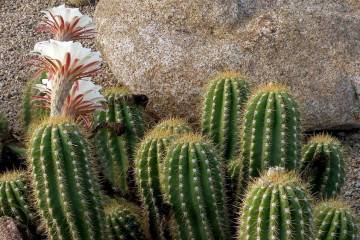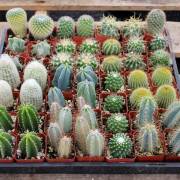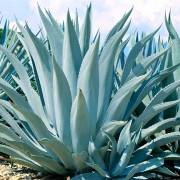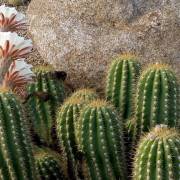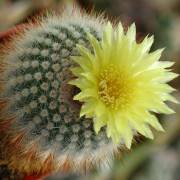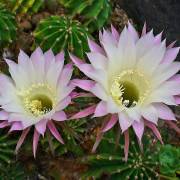Blooming cactus: necessary conditions at home
Content:
Cacti stand out from all plants for their unusual and sometimes bizarre appearance. This is a unique family. They grow on mountain peaks and in deserts where there is no other vegetation. There are many shapes and sizes of cacti. Its body can be in the form of a sphere or a disk, with or without stems, there are flowering plants and just greenery. Almost everyone belongs to succulents. Many are covered with thorns on top. To date, specimens with leaves instead of the usual thorns have been artificially bred.
Types of blooming cacti
One of the well-known species that assumes the flowering of a cactus is Mammillaria. He won the heart of more than one grower. The variety of forms makes it possible to use it for interior design, creating original flower arrangements.
Their feature is the replacement of ribs with tubercles. It is thanks to their presence that the plant is able to retain moisture inside and reflect the scorching rays of the sun. The flower's habitat is the vast expanses of the United States from the southern part to the center of Latin America. This type includes 200 officially registered representatives. They can be seen in the botanical garden, flower greenhouses.
Luthi
The plant is formed by several dark green colored heads. They are similar in shape and appearance to a pear. There are thorns all over the surface. Flowers are located at the very top. As a rule, blooms in a pair of purple flowers with white centers. Bright yellow stamens are also visible. The flowers themselves are only up to 3 cm in diameter.
Wilda
A distinctive feature lies in the many thin stems of rich green color. Up to 2 cm in diameter. Golden thorns are located over the entire surface. When this cactus blooms, it is almost all in pale yellow flowers. An amazing sight! The middle is more intense - lemon color. Babies are formed around the cactus. For this reason, it grows rapidly.
Other
Bauma cactus is represented by a small shrub consisting of light green columns. Covered with whitish thorns. Soft to the touch. It is located in flocks. It develops in the same way. During the flowering period, it exudes a pleasant aroma. Decorated with yellow, small flowers.
The Bokasana variety is unique in that its barrel is made in the form of a cylinder. It is all covered with thorns that look like hooks, and also with a white pile. The thorns are hard. The pile envelops the stem and because of this it acquires a bluish-gray color. The cactus grows only up to 6 cm. It is interesting how this species of cactus blooms. At the very top, in the form of a wreath, there are double flowers, pink and white in color.
Features of flowering cactus
The task for the cactus to bloom is not an easy one. This requires proper care, and first - the creation of conditions close to its natural habitat. Sometimes it can take more than one year to master the art of caring for a plant. You need to know all the intricacies of how to take care of an exotic pet.
Flowering time
Perhaps one of the most important moments for a cactus grower is the flowering of a cactus at home.The timing and time of flowering is different for different varieties. So, there are those that are gaining and throwing out color in the spring at the age of 2 months. In winter, the Decembrist (or Schluberger's Christmas cactus) blooms.
The flowering of the Decembrist is long for this family - from December to January. One flower lives for more than 1 - 2 days. Experienced cactus collectors breed different species with different “flower periods”. Long-papillary Mammillaria is another amazing species. The surface is dotted with long papillae. They are colored, like the whole body of a cactus, in a rich green color. Blossoming occurs in large flowers of a bright lemon color.
How many times in a life does a cactus bear fruit?
Many people do not know that cacti not only bloom, some species also bear fruit. For example, the inhabitants of the South of America and Africa eat these fruits. This is a normal diet for them. Everyone eats: seeds, fruits, leaves. To date, more than 170 fruiting species are known.
Decembrist
On the Decembrist, 30 days after flowering, if pollination has taken place, green fruits are formed. For pollination to occur, there must be zygocactus of different colors nearby. The likelihood of fruiting with such plants is high. The ripening period lasts from 5 to 7 months. In place of the flowers, berries of a dark ruby hue appear. Such fruits taste sour, and inside there are many tiny seeds.
Hilocereus
Dragon Heart or Hilocereus is another fruit-bearing plant variety. Fruiting time is May - November. Up to 6 harvests in a row are taken in one season. As you might guess, the yield is decent. Fruit weight may vary. Varies from 150 g to 1 kg.
Yellow Pitaihaya
Yellow Pitaihaya complements the collection of fruit bearing cacti. They taste juicy, with tender pulp. In common people known as the queen of the night.
Colombia
In appearance, this is an ordinary cactus growing at home in a pot. All the unusualness of the plant is in night flowering. By morning, the flowers are already withering. Some botanical gardens offer special tours dedicated to this plant. Time of the event - night.
Reasons why it does not bloom
A cactus may not bloom for several reasons:
- Non-blooming species. Florists with experience already know that there are certain types of non-flowering cacti that do not have flowering in nature. Before buying a plant, you need to carefully read the information about it: about breeding, about growing conditions, how to care. All information will be helpful. If necessary, you can seek advice from a specialist.
- Failure to comply with the rules of care.
- Lack of a dormant period. At the same time, the rest time for "Americans" and "Africans" is different. For some it is summer, for others it is winter. When purchasing a cactus, you need to find out what species it belongs to.
- Grafted plants.
- Large landing capacity.
- Unsuitable soil.
In order for a cactus to bloom, grafting from a flowering plant to a non-flowering plant is required. An example is the graft of epiphyllum on non-flowering peiresque. The best time for such a vaccination is winter.
Why does a cactus give a baby, and not bloom
The presence of children is a signal of an exceeded nitrogen norm in the soil. Cactus experts say phosphorus and potassium should also be added. It is they who stimulate the flowering process. Removing the babies will make their number even larger, so you need to change the composition of the soil with the help of dressings. In the case of the formation of children, all the forces of the plant go to them, in fact, for reproduction (by the vegetative method).
Especially cactusists point out to beginners that cacti from third generation babies and seeds do not bloom.At home, the plants located on the windowsills do not receive enough light in its full composition and intensity. This leads to the development and growth of green parts. There are no flowers in this case.
Further care of the cactus at home
Cacti are common at home. You can often see a computer and a nearby cactus as the main "absorber" of negative radiation from technology. However, few people think in such a situation that the plant needs care and appropriate conditions, and a place next to the monitor is not the best option.
Before buying a plant, you need to carefully read about its homeland, natural habitat, living conditions in the apartment, etc. Only in this case the new "pet" will grow up beautiful and healthy. Cacti do well in groups of their own kind. You can make a small home garden.
To successfully grow exotic unique plants at home, you need to consider the influence of the following factors:
- temperature;
- illumination;
- humidity level;
- soil composition;
- systematic watering.
The growing season runs from March to September. And the rest time is October - February.
Lighting
The best lighting is diffused and bright light. It is required by almost all representatives of this culture. When there is not enough light, the plant stretches noticeably in height, regardless of its shape. The color fades: instead of rich green, it becomes light green. And, of course, in such conditions it is impossible to see how a cactus blooms.
When there is too much light (this situation also occurs), a kind of "tan" appears on the sunny side of the flower. In this case, the plant should not stand very close to the glass of the window. During particularly hot periods (for example, at noon), artificial shading should be created. It is not recommended to touch the flower pot, as this will become unnecessary stress, due to which the cactus will drop both the buds and the flowers on it.
Watering
It is believed that succulents can be watered very rarely, because they glow and retain moisture. Of course, excess water is much worse for them than dry soil. However, there is no need to delay with this either. For flowering, it is imperative to water systemically. Enough once every 7 days in the summer. Water is suitable only for several days. It is necessary to moisten only the clod of earth in which the cactus grows. No need to fill with water.
The autumn reduction in watering is associated with a dormant period when the cactus no longer absorbs water from the soil. In this case, it is better to leave the plant dry than with damp soil. This will inevitably lead to root rot. In winter, the soil should always be dry. It is enough to water a little once every 30 days.
With an increase in the duration of daylight hours, it is required to carry out the procedure for "waking up" from hibernation. For this purpose, they are sprayed with water at a temperature of +50 degrees. After 7 days, water well. This will transition to more frequent watering during the summer.
Temperature
The temperature regime has a significant impact on the life of a cactus. Slight fluctuations of 2 degrees from +26 to +28 do not cause any changes in the development of the plant. And when the temperature rises above +30, then metabolic processes are already affected. They are slowing down. For the cactus, this is external stress, so the buds begin to drop.
In winter, the comfortable temperature ranges from +10 to +15 degrees. When maintaining the temperature regime, the type of plant is taken into account. So, for echinopsis and mammillaria, it is enough to maintain +12, +15 degrees. For ecobaria and neobessia, even lower temperatures from +0 to +5 degrees are sufficient.
Cactusists celebrate this period especially, because an important process is taking place - the laying of buds. The flowering period will also depend on how correctly the dormant period passed.The plant will not need to spend energy fighting stress. All the energy will go into the formation of future flowers.
Air humidity
Cacti prefer moderate humidity levels. Dry, warm air is not suitable for them, despite the natural habitat conditions. It is necessary to periodically ventilate the room, avoiding drafts. In the morning or in the evening, spraying from a fine spray is useful to create a kind of "fog" over the plants.
Under suitable conditions and proper care of cacti, they will certainly bloom, provided that it is a flowering variety. Lack, excess watering, dry air, high or low temperatures and non-observance of other conditions lead to plant diseases and lack of flowers. From time to time it is helpful to inspect the cacti.
